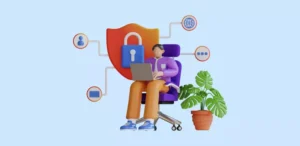There is a big impact of the Internet on our daily life. Electronic devices multimedia, smartphones, and computers are things we have to deal with every day. The internet is becoming more and more important nearly every day as it is one of the newest and forward-looking media and surely the medium of the future.
It is a source of information. There is a huge amount of information available on the Internet for just about every subject known to man, for example from government law and services, market information to new ideas and technical support. Let us know what is the Internet. And its definition, facts, history, and description.
What Is The Internet?
The Internet stands for International Network, it is a worldwide network of computers that allows millions of people to share information and their ideas through text, video clips, audio, images, etc. using their computers across the world. Internet Networks are a ‘Network of Networks’ that consists of millions of public networks across the global and global scope of local. Basically, a network is a group connected by two or more computer systems.
It can also be used as a tool to communicate; we can send an e-mail or use a chat room or social media like Facebook, WhatsApp, Twitter, etc. to contact a person who is physically a thousand kilometers away.
The Internet can be defined in many ways as follows:
- It is a worldwide global system of interconnected computer networks.
- Internet uses the standard Internet protocol (IP and TCP).
- Every computer on the internet is identified by a unique IP address.
- The IP address is a unique set of numbers such as (422.45.422) which identifies a computer location.
- A special computer DNS (Domain Name Server) is used to give a name to the IP address so that the user can locate a computer by name. For example, a DNS server will resolve a name https//www.studyinsta.com to a particular IP address to uniquely identify the computer on which this website is hosted.
- It is accessible to every user all over the world.
What is the World Wide Web? (WWW)
WWW was introduced on 13th March 1989. The World Wide Web is a system of internet servers that support hypertext and multimedia to access server internet protocol on a single interface. The World Wide Web is often abbreviated as the Web or WWW. The World Wide Web is a way of exchanging information between computers on the internet.
What is a Web Page?
The backbone of the Internet world wide web is made of files, called pages or web pages, containing information and links to resources both text and multimedia throughout the Internet. It is created using HMTL. There are basically two main types of web pages static and dynamic. The main or first page of the Website is known as the home page.
What is a Website?
A group of Web pages that follow the same theme and are connected together with hyperlinks is called a Website. In other words, A Website is a collection of digital documents, primarily HTML files, that are linked together and exist on both Webs under the same domain. For example, https://vidyaleaf.com is a Website while https:/vidyaleaf.com/microcomputer is a web page.
What is a Web Browser?
A web browser is application software that allows us to view and explore information on the web. Users can request any web page by just entering a URL into the address bar. Web browsers can show text, audio, video, animation, and more.
It is the responsibility of a web browser to interpret text and commands contained in the web page. Earlier web browsers were text-based while nowadays graphical-based or voice-based web browsers are also available. The following are the most common web browsers available today:
- Internet Explorer
- Google Chome
- Mozilla Firefox
- Opera
- Safari
- Sea Monkey
- Netscape Navigator
What is a Web Server?
The Web browser is a client that requests HTML files from Web servers. The server computer will deliver the Web pages to the computers that request them and also do the other processing with the web pages.
Every Web server that is connected to the Internet is given a unique address, i.e. IP address made up of a series of four numbers between 0 to 255 separated by periods. e.g. Apache HTTP Server, Internet Information Services (IIS), Lighttpd, etc.
What is Web Address and URL?
A Web address identifies the location of a specific Web page on the Internet, such as http://www.studyinsta.com. On the Web, Web addresses are called URLs. URL stands for Uniform Resource Locator. It is the Web address for a Website or a Web page. Tim Berners Lee created the first URL in 1991 to allow the publishing of hyperlinks on the World Wide Web. e.g. “http://www.google.com/services/index.htm”
- https:// – Protocol identifier
- www – Protocol Ideentifier
- Vidyaleaf.com – Domain Name
- /services/ – Directory
- index.html – Web page
Who Invented The Internet?
The Internet began in the 1950s” s by Vint Cerf and Robert E. Kahn. Vint Cerf and Robert E. Kahn are known as the father of the Internet. IP and TCP are the backbones of the Internet and we can’t access it without IP and TCP.
TCP – Transmission Control Protocol
It provides reliable transport service, i.e. it ensures that the message sent from sender to receiver is properly routed. TCP converts messages into a set of packets at the source which is then reassembled back into messages at the destination.
IP – Internet Protocol
It allows the different computers to communicate by creating a network of networks. IP handles the dispatch of pockets over the network. It maintains the addressing of packets with multiple standards. Each IP packet must contain the source and destination address.
There are many organizations that are responsible for the smooth operation of the Internet such as ISOC (Internet Society)
- IAB (Internet Architecture Board)
- IETF (Internet Engineering Task Force)
- IESG (Internet Engineering Steering Group)
Benefits of the Internet
It covers almost every aspect of life, one can think of. Here, we will discuss some of the benefits of the Internet.
It allows us to communicate with people sitting at remote locations. There is a various app available on the web that uses the Internet as a medium for communication.
Apart from communication and a source of information, it also serves as a medium for entrustment. Following are the various modes for entertainment over the internet – YouTube, Online games, Songs, Social network apps, etc.
- Allows you to easily communicate with other people.
- Global reach enables one to connect with anyone on the internet.
- Publishing documents on the internet saves paper.
- A valuable resource for companies to advertise and conduct business.
History of the Internet
In fact, long before technology for the creation of the Internet came into existence, many scientists had already anticipated the existence of a worldwide network of information.
Nikola Tesla toyed with the idea of a “world wireless system” in the early 1900s and envisioned mechanized, searchable storage systems of books and media in the 1930s and 1940s, such as Paul Oleate and OneNever Bush Visionary thinkers.
Nevertheless, the first practical plans for the Internet did not come until the early 1960s, when MIT’s J.C.R. Licklider popularized the idea of a “space network” of computers.
Shortly thereafter, computer scientists developed the concept of “packet switching”, a method of effectively transmitting electronic data that would later become one of the Internet’s major building blocks.
In 1960, The University of California, the University of Utah at Los Angeles was added as the start of the ARPANET (Advanced Research Projects Agency Network) using a 50 Kbits circuit.
It was the world’s first operational packet-switching network. The global of this project was to connect computers at different universities and U.S. Defence.
In 1969, the first message: node-to-node communication from one computer to another was delivered by ARPAnet. The first computer was discovered at a research lab at UCLA and the second at Stanford; each was the size of a small house.
The message – ‘Login’ was small and simple, although it crashed the ARD network. The first two letters of the note are only received by the Stanford computer.
Then in the 1970s two scientists, Robert Kahn and Vinton Cerf developed Transmission Control Protocol (TCP) and Internet Protocol (IP), Then on January 1, 1983, ARPANET adopted Transmission Control Protocol and Internet Protocol. From there, researchers began assembling the “Network of Networks” that became the modern Internet.
The Internet world became a more recognizable form in 1989 when computer scientist Tim Berners-Lee invented the World Wide Web or WWW. It is a vast collection of information on the Hyperlink Hypertext document called a webpage.
- Hyperlink – It is a link i.e. used to navigate from one webpage to another page.
- Hypertext – It is the text which contains the hyperlink.
The National Science Foundation created a new high-capacity network called NSFnet which was more capable than ARPANET in the mid-’80s another federal agency. The only limitation of NSFnet was that it allowed only academic research on its network and not any kind of private business on it. As a result, private organizations and people started working to build their own networks, which were later interconnected with ARPANET and NSFnet to form the Internet.


